Delicious and easy Homemade Soft Pretzels, which are soft and pillowy, with the perfect chew. These pretzels are great for snacking and entertaining, and perfect served alongside some grilled sausages! Recipe with step-by-step photos.

Soft Pretzels
If there is one reliable snack that my children will always devour, it would be soft pretzels. In Zurich, Brezel stands can be found all over town with a wide assortment of toppings on offer – sea salt (called Natur), pumpkin seeds, poppy seeds, and one of my favourites: raclette cheese.
In Zurich, you can also buy soft pretzels which have been prepared as sandwiches, but nothing really beats a warm pretzel, sprinkled simply with sea salt, and baked fresh from the oven.
For me, the best pretzels are those which are soft and pillowy, with just enough chew to make them moreish.
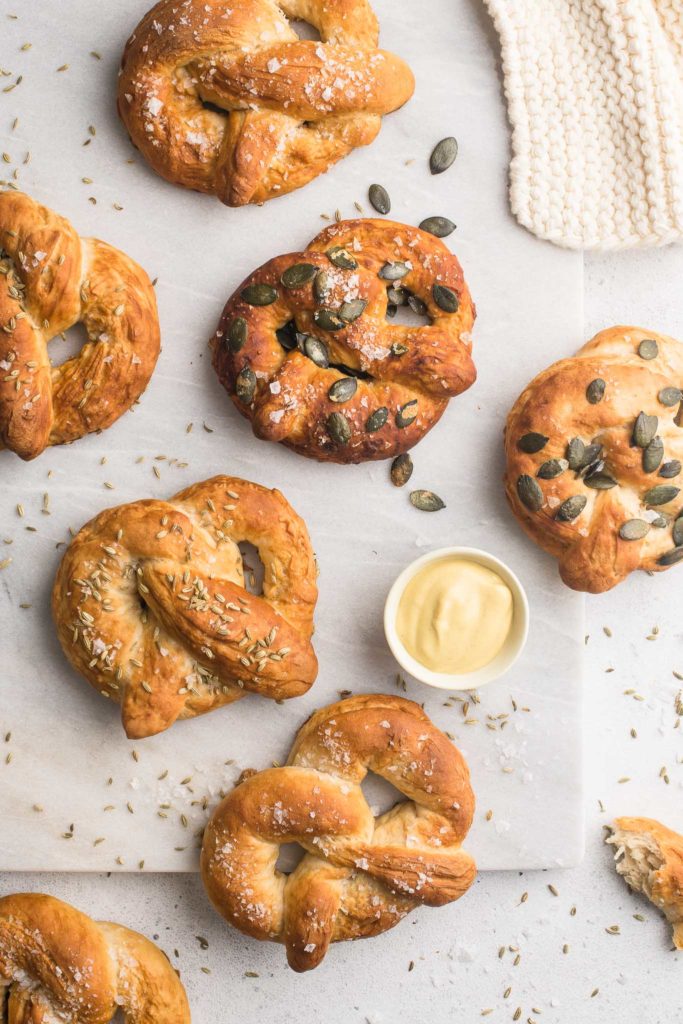
Soft Pretzel Recipe
Although it is really easy to buy soft pretzels where I live, they happen to be fairly simple to make at home. This is especially so if you already happen to be a confident bread baker.
And the bonus is not only having a whole batch of warm soft pretzels to devour just as they come out of the oven, but making your own pretzels means you can play around with the flavours and toppings.
The shop-bought pretzels can be quite salty, which I happen to love, but they can be somewhat over-powering and unhealthy for young children. Thankfully, my kids love pumpkin seeds and fennel seeds, so I generally stick to seeds and other grains for the kids. They also love their pretzels plain.
Pretzel Dough
In Switzerland, the soft pretzel dough is actually used to make a variety of different shapes of bread rolls, such as dinner rolls (Laugenbrötli) or baguettes (Laugen-Parisette); the latter is commonly used to make Swiss-style hot dogs.
So once you get the hang of making pretzel dough, there are many different ways to shape the dough to keep things interesting. My kids particularly love the Laugen Grittibänz, which are pretzel gingerbread men, sold in bakeries here around Christmas time.
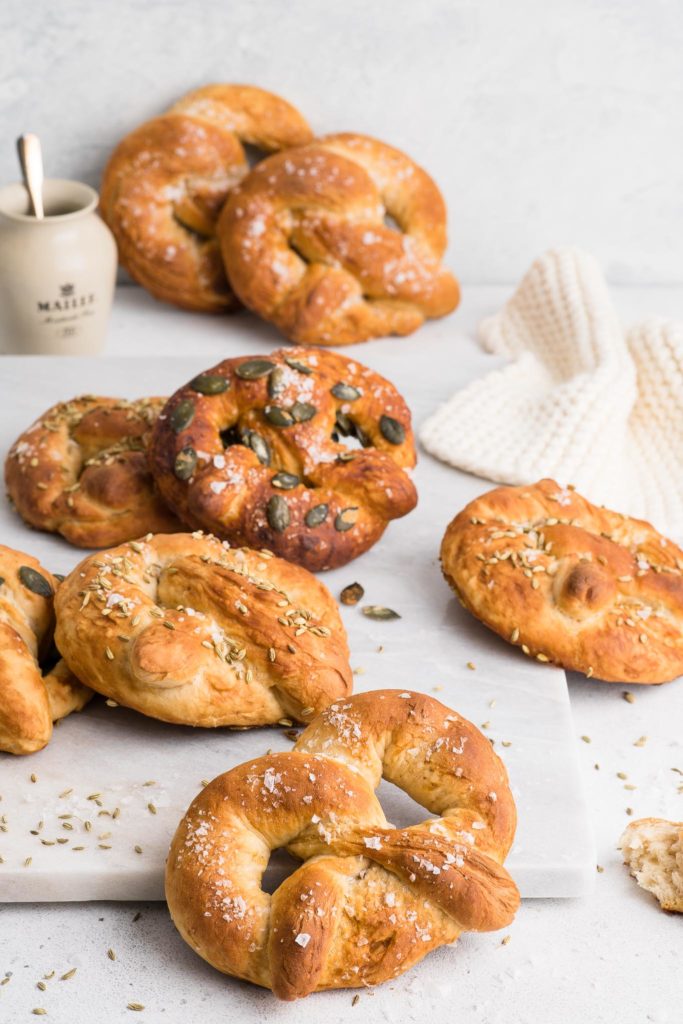
Pretzel Recipe
All pretzel recipes start off with making bread. You make the bread dough as per normal, but to transform the bread dough into a pretzel, you need to submerge the shaped dough into a water bath containing baking soda, and this water bath is what will give the pretzels their signature colour and chewy texture.
The longer you submerge the dough in the baking soda bath, the deeper the bronzed colour, and the chewier the pretzels will be. However, I would not leave the dough in the water bath for longer than 5-10 seconds. Otherwise, the dough will become difficult to handle from all of the moisture, and too much baking soda can give the pretzels a metallic after-taste.
Homemade Lye Water
All bakeries which make and sell pretzels use lye to give pretzels their signature bronze colour and taste. It is possible to buy lye flakes or lye pearls to make your own lye water at home, so that you can recreate the same look and taste with your homemade pretzels.
However, as lye can be quite potent and cause irritation, it is not readily available for household use. If you are a serious baker and manage to buy lye for home use, it is often sold with strict instructions for safe use and handling (often a combination of gloves and safety goggles).
An alternative to commercial lye is homemade lye using simply baking soda and water. Baking soda is an alkaline substance, and baking the baking soda intensifies its alkaline properties.
So a solution containing baked baking soda will be more alkaline than just using normal baking soda. Baked baking soda will not be as strong as lye, but I think it gives very good and similar results.
When making homemade lye water to make pretzels, I recommend a ratio of 1:2. That is, 1 part baked baking soda to 2 parts water. For the recipe below. I recommend making a solution of lye water containing 1 cup baked baking soda to 2 cups water.
For more details, please see my recipe for making homemade Lye Water with step-by-step instructions.

Why This Recipe Works
What I love about this particular pretzel recipe is that the buns are soft and fluffy; you could indeed skip the baking soda bath and use this recipe to make soft bread rolls.
But turning these buns into a pretzel gives them that signature bronze colour and chewy taste, without losing the soft and moreish texture.
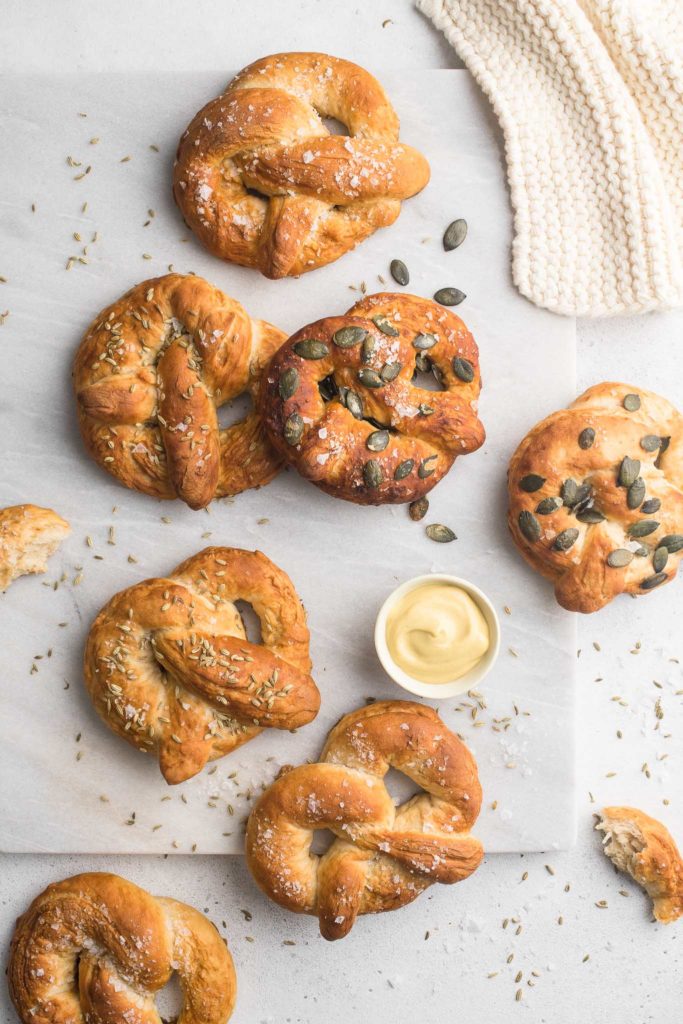
How to Make Pretzels
Step 1
Measure the flour, salt, sugar, yeast into the bowl of an electric stand mixer, fitted with a dough hook. Lightly mix the ingredients together.

Step 2
With the speed on low, slowly add the warmed milk.
Keep mixing on low speed until the ingredients come together into a sticky dough.
Add the butter, about a tablespoon at a time, waiting for it to be completely incorporated before adding the next tablespoon.
Once all of the dough ingredients have been added, mix the dough on a low-medium speed for about 15-20 minutes, or until you have a soft and smooth ball of dough. When you poke the dough gently, it should bounce back immediately.

Step 3
Lightly oil a large bowl. Place the dough into the bowl, and cover with some plastic wrap or a reusable bowl cover.
Leave the dough somewhere warm for 1 to 1.5 hours, or until the dough has doubled in size.
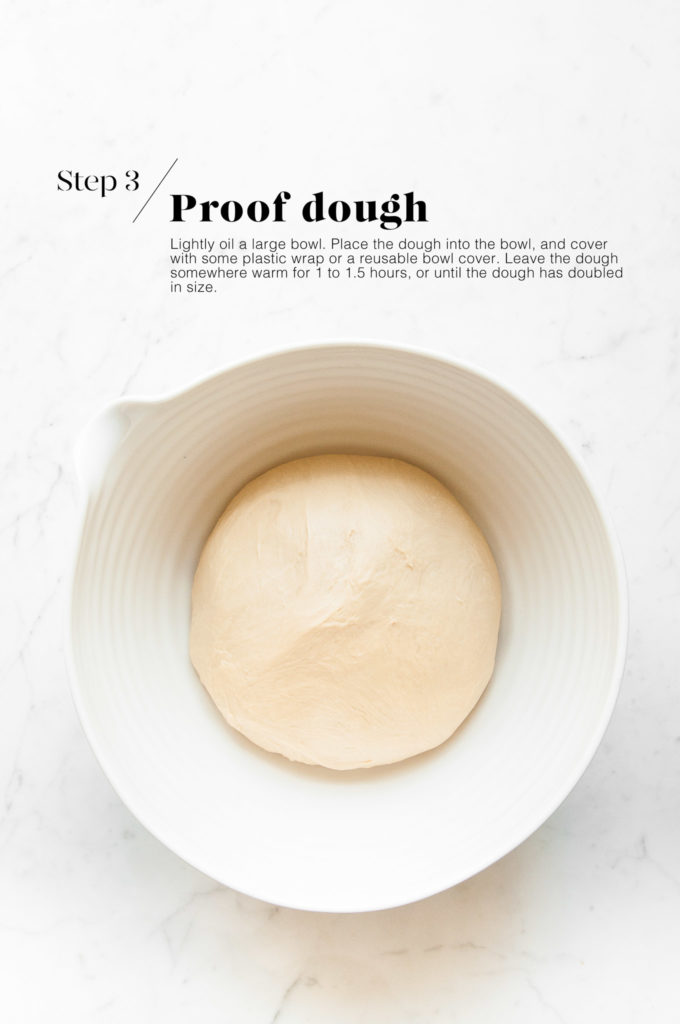
Step 4
Once the dough has doubled in size, punch back the dough to release all of the air. Knead the dough gently a few times.
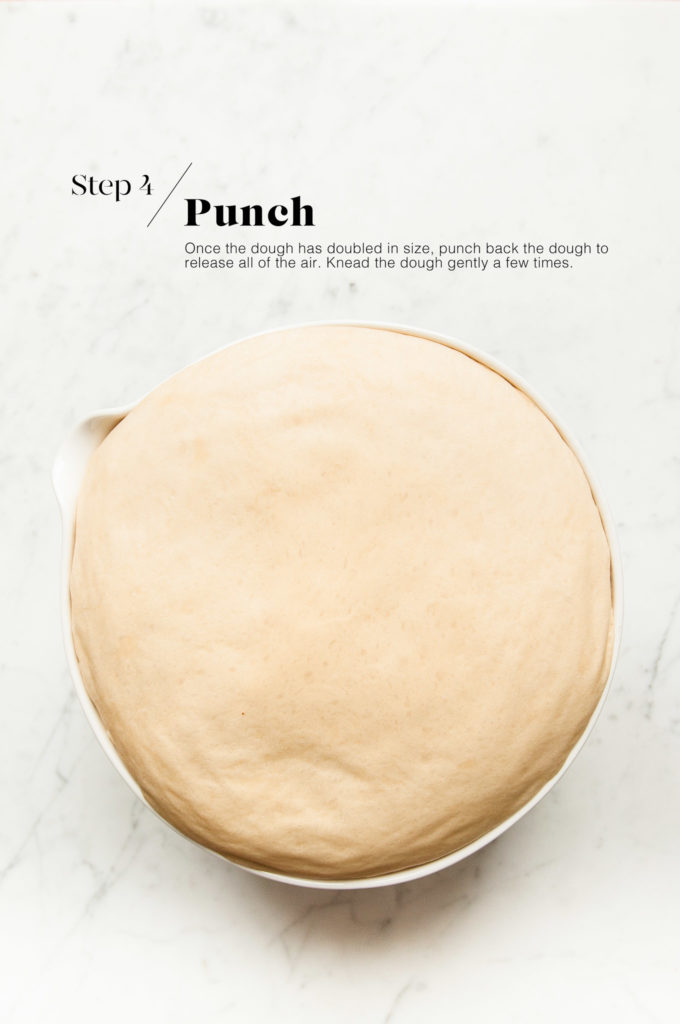
Step 5
Weigh the dough and divide this number by 10 to get the weight for each bun. Divide the dough into 10 equal portions. If you wish to make smaller pretzels, divide the dough into 12 pieces.

Step 6
Line a large baking tray with baking paper.
Roll each piece of dough into a smooth ball, and then roll each ball into a log measuring about 60 cm/24 inches.
Form each log into a U shape. Cross over the ends to form a loop. Cross over the ends once again. Bring the ends down over the loop to form the pretzel shape.
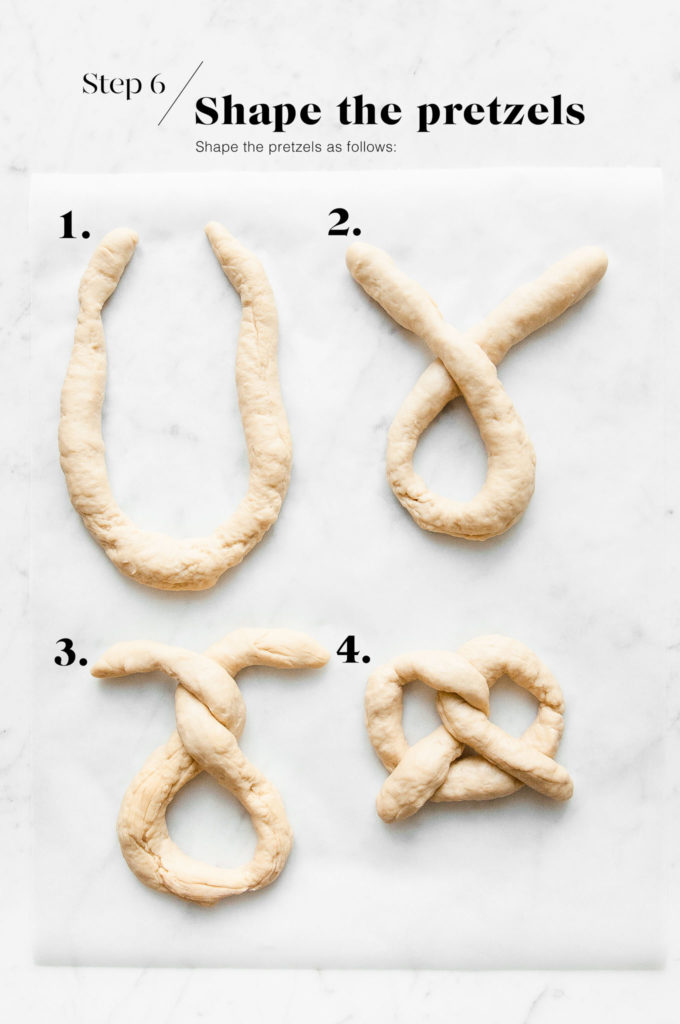
Step 7
Place the pretzels onto the lined baking tray.
Repeat the above steps until all of the pretzels have been formed.
Place the tray of pretzels somewhere warm for about 30 minutes to puff up slightly.
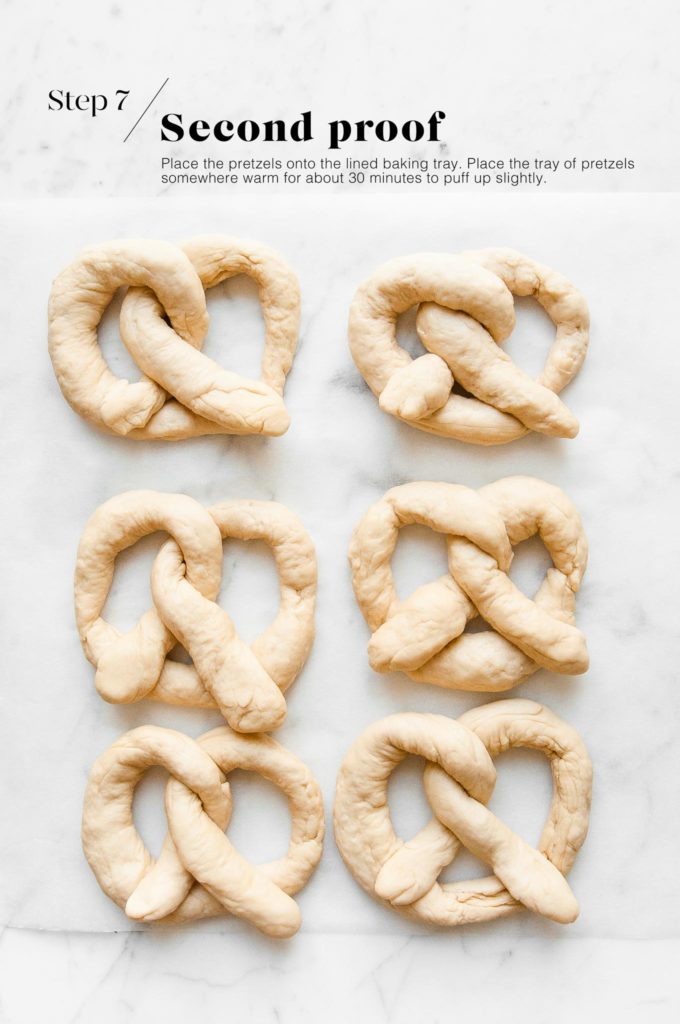
Step 8
While the dough is proving for the first time, bake the baking soda in a large oven-proof dish for 1 hour. I use a baking dish which is large enough to later hold 500 ml/2 cups of water. Let the baking soda cool completely.
To make the baking soda bath (or lye water), add the water to the baked baking soda and use a whisk to dissolve everything together. Sometimes there are lumps of baking soda which will not dissolve – this is ok, so long as they do not stick to the dough.
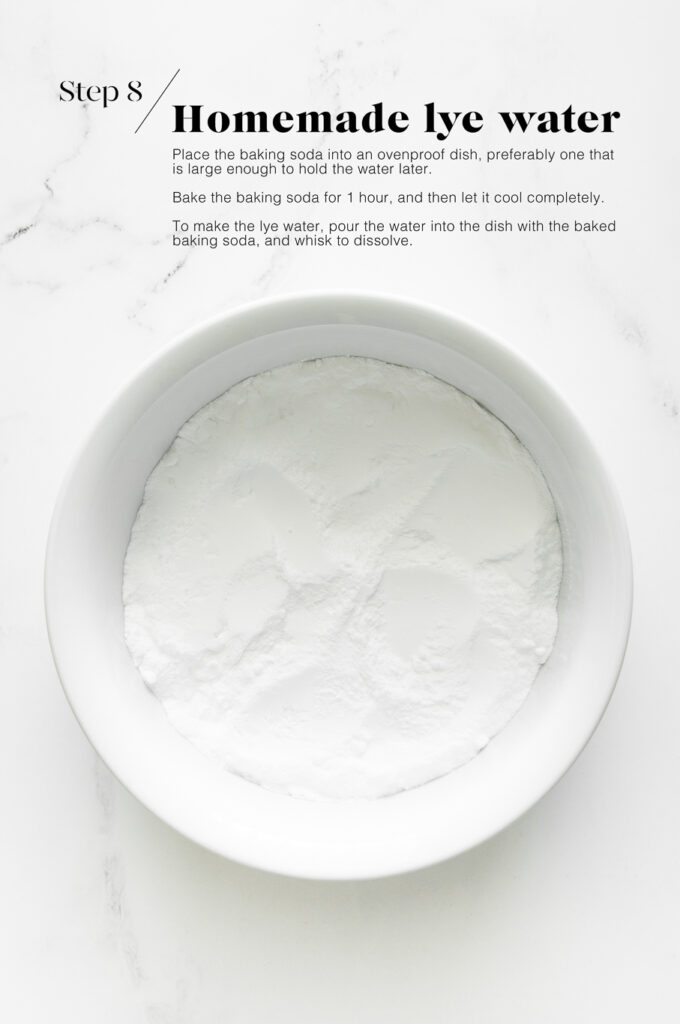
Step 9
Carefully dip one pretzel at a time in the baking soda bath. As the lye water can irritate your skin, wear gloves and/or use a large metal spider or large slotted spoon to submerge the pretzel in the baking soda bath.
Submerge the pretzel for 5-10 seconds in the baking soda bath.
Drain off as much water as possible. Transfer the pretzel dough from the lye water back to the lined baking tray. Try to handle the pretzel dough carefully and to not deflate them. However, don’t worry if they look soggy after their water bath.
Repeat the above steps with the remaining pretzel dough.
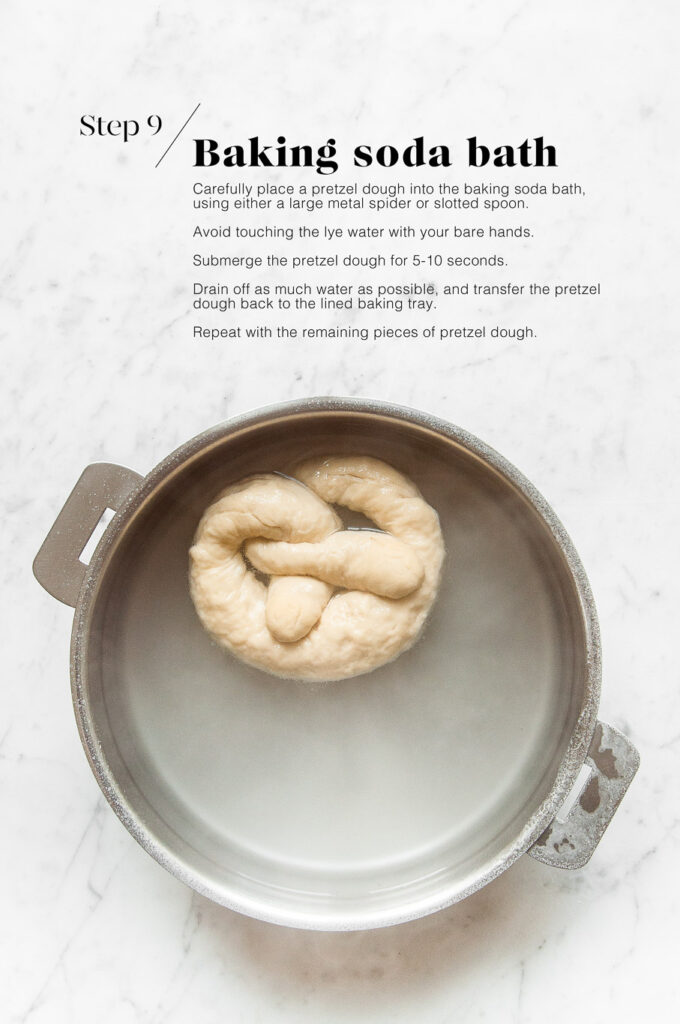
Step 10
Preheat the oven to 200°C/390°F (without fan).
Sprinkle the pretzels with sea salt and/or your choice of topping. Bake the pretzels for 15-20 minutes, or until they are golden and cooked through.
Brush the warm pretzels with some milk to keep them glossy. Serve warm.
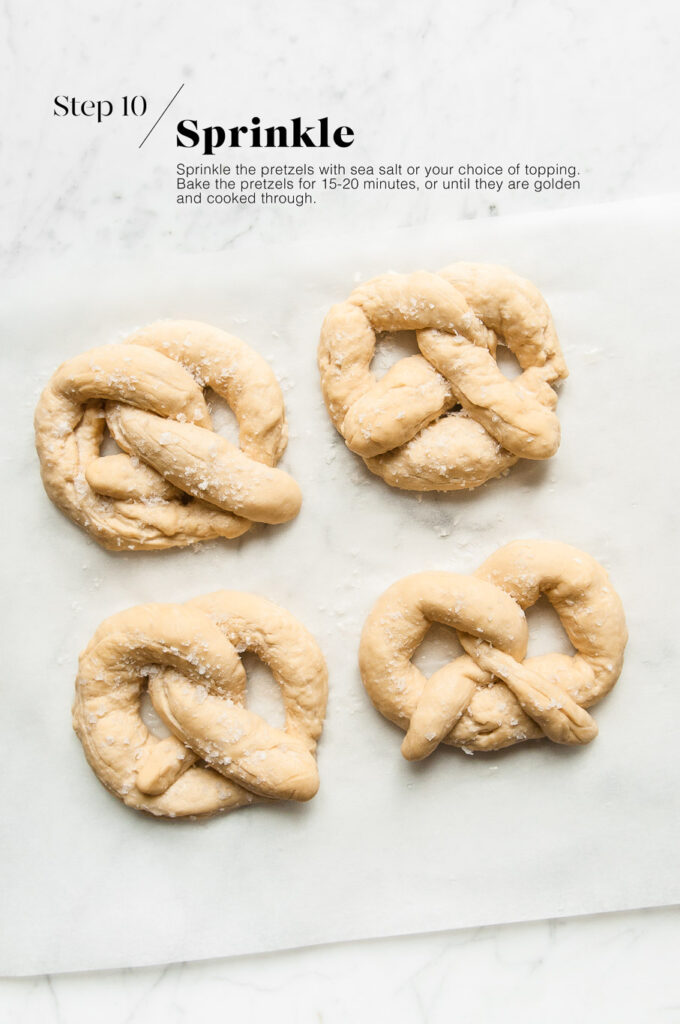
What to Serve with Soft Pretzels
In Europe, large soft pretzels are often eaten plain; they are usually quite salty and savoury in flavour, and are filling in themselves. They are frequently sold in pubs or food stands alongside beer and other beverages.
But pretzel stands have had to become more creative with how they serve their pretzels, and most vendors will also serve them with a variety of sandwich fillings. The most common pretzel sandwich fillings include ham, salami, Fleischkäse (a luncheon meat), cheese, or cream cheese. You might also find some lettuce and pickles in your pretzel sandwich, but these tend to be more upmarket.
If my children are going with their school to the forest (Waldtag) where they will grill their own sausages over an open fire, I will often pack a small soft pretzel for them to eat alongside their sausage.
Unlike in America, Europeans do not eat their pretzels with dipping sauces, unless the meal also involves sausages. In which case, the sauces are typically limited to a simple ketchup (tomato sauce) and hot mustard. But then again, American culture is very popular in Europe, so I won’t be surprised if the trend of more exotic dipping sauces crosses the pond soon!
If I am baking soft pretzels to serve at home as part of a meal (usually a child-friendly meal), I will often serve them alongside cooked Wiener sausages or Frankfurters and a salad.
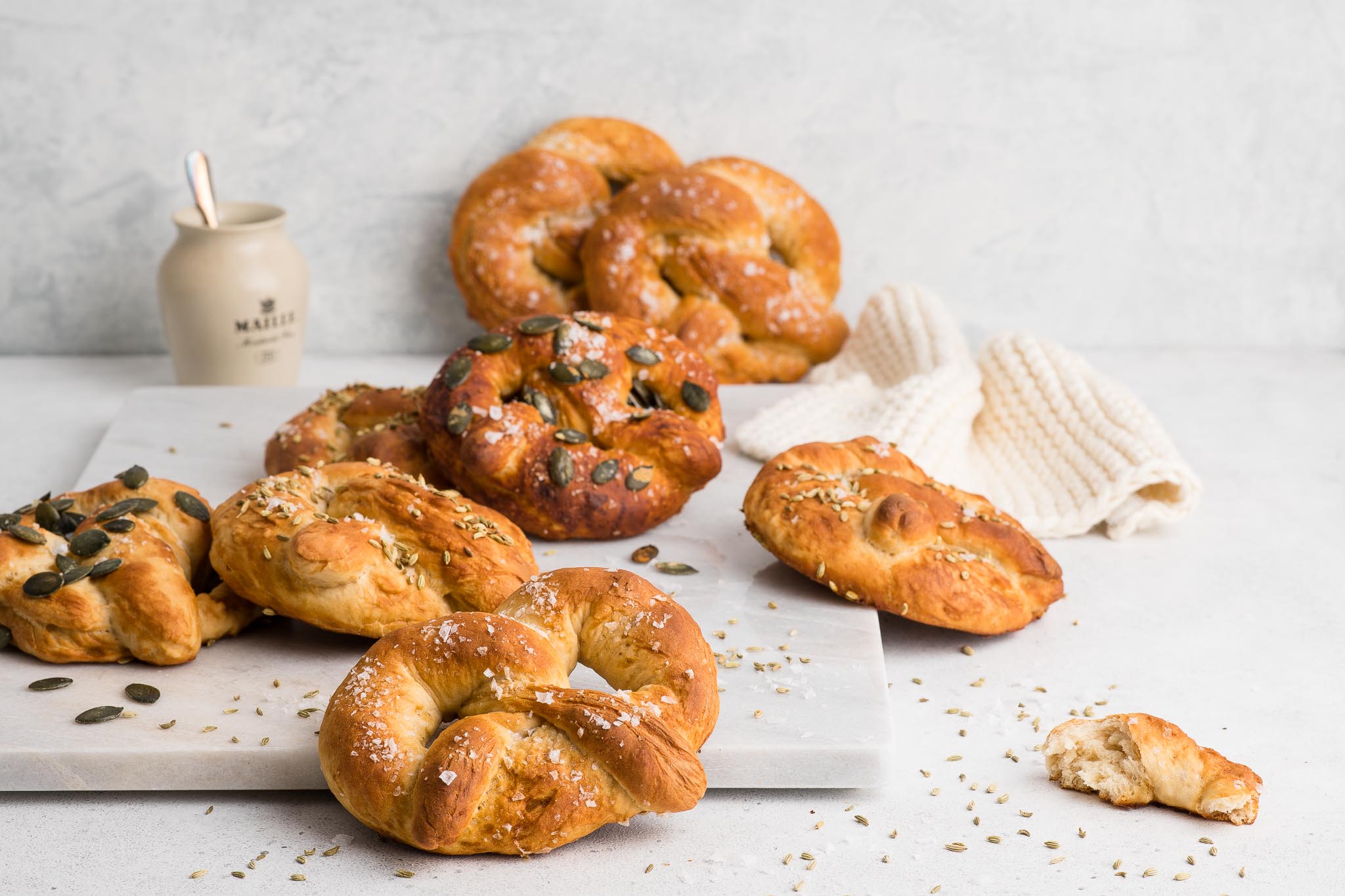
Homemade Soft Pretzels
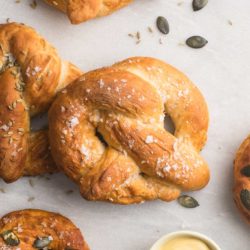
- Resting Time: 2 hours
- Prep Time: 30 mins
- Cook Time: 20 mins
- Total Time: 50 minutes
- Yield: Makes 10
- Category: Bread
- Method: Oven
- Cuisine: German, Swiss
Delicious and easy Homemade Soft Pretzels, which are soft and pillowy, with the perfect chew. These pretzels are great for snacking and entertaining, and perfect served alongside some grilled sausages! Recipe with step-by-step photos.
Ingredients
For the pretzels
- 500 g (3 1/3 cup) strong white bread flour
- 1 1/2 teaspoons fine salt
- 3 tablespoons caster sugar
- 7 g (2 teaspoons) instant yeast (see Kitchen Notes)
- 300 ml (1 cup plus 3 tablespoons) full cream milk (whole milk), warmed slightly to about 37°C/98°F
- 50 g (1/2 stick) butter, softened
For the baking soda bath
- 230 g (1 cup) baking soda
- 500 ml (2 cups) water
For the pretzel toppings
- coarse sea salt flakes
- fennel seeds
- pumpkin seeds
- poppy seeds
To serve
- 1/4 cup milk
Instructions
To make the pretzel dough
- Measure the flour, salt, sugar and yeast into the bowl of an electric stand mixer, fitted with a dough hook.
- Lightly mix the ingredients together.
- With the speed on low, slowly add the warmed milk.
- Keep mixing on low speed until the ingredients come together into a sticky dough.
- Add the butter, about a tablespoon at a time, waiting for it to be completely incorporated before adding the next tablespoon.
- Once all of the dough ingredients have been added, mix the dough on a low-medium speed for about 15-20 minutes, or until you have a soft and smooth ball of dough. When you poke the dough gently, it should bounce back immediately.
- Lightly oil a large bowl.
- Place the dough into the bowl, and cover with some plastic wrap or a reusable bowl cover.
- Leave the dough somewhere warm for 1 to 1.5 hours, or until the dough has doubled in size (see Kitchen Notes below).
- During this time, start baking the baking soda (see instructions below for the baking soda bath).
- Once the dough has doubled in size, punch back the dough to release all of the air.
- Knead the dough gently a few times.
- Weigh the dough and divide this number by 10 to get the weight for each bun.
- Divide the dough into 10 equal portions. Alternatively, if you wish to make smaller pretzels, divide the dough into 12 pieces.
To shape the pretzels
- Line a large baking tray with baking paper.
- Roll each piece of dough into a smooth ball, and then roll each ball into a log measuring about 60 cm/24 inches.
- Form each log into a U shape.
- Cross over the ends to form a loop.
- Cross over the ends once again.
- Bring the ends down over the loop to form the pretzel shape.
- Place the pretzels onto the lined baking tray.
- Repeat the above steps until all of the pretzels have been formed.
- Place the tray of pretzels somewhere warm for about 30 minutes to puff up slightly.
To make the baking soda bath (see my recipe for Homemade Lye Water for step-by-step photos)
- Preheat the oven to 120°C/250°F (without fan).
- Place the baking soda in an oven-proof dish which is large enough to hold the water later.
- Bake the baking soda for 1 hour.
- Remove the dish from the oven and let the baking soda cool completely.
- When you are ready to prepare the pretzels in the next step below, make the baking soda bath (or lye water) by dissolving the water in the baked baking soda. Whisk until everything is dissolved. Sometimes, there are lumps of baking soda which remain, which is fine but make sure these do not stick to the dough later.
To prepare the pretzels
- Carefully place a pretzel dough into the baking soda bath using a large metal spider or slotted spoon. As the baking soda bath can irritate the skin, wear some gloves and/or avoid touching the water with your bare hands.
- Submerge the pretzel dough in the baking soda bath for 5-10 seconds.
- Lift the pretzel dough out of the water, and drain off as much water as possible.
- Transfer the pretzel dough from the baking soda bath back to the lined baking tray.
- Try to handle the pretzel dough carefully and to not deflate them. However, don’t worry if they look soggy after their water bath.
- Repeat the above steps with the remaining pretzel dough.
To bake the pretzels
- Preheat the oven to 200°C/390°F (without fan).
- Sprinkle the pretzels with sea salt and/or your choice of topping.
- Bake the pretzels for 15-20 minutes, or until they are golden and cooked through.
- Brush the warm pretzels with some milk to keep them glossy.
- Serve warm.
Kitchen Notes
 DIFFERENT TYPES OF FLOUR
DIFFERENT TYPES OF FLOUR
* For Swiss readers: I use Zopfmehl (or farine pour tresse) when making bread and enriched dough.
 DIFFERENT TYPES OF YEAST
DIFFERENT TYPES OF YEAST
* Please note that there is a difference between instant yeast (also called instant dried yeast or fast-action dried yeast) and dried yeast (also called active dry yeast). If you are not sure what type of yeast you have, please check the packaging for instructions on how to use the yeast.
* With instant yeast, you can add it directly to the flour mixture without having to activate it first.
* With dried yeast, you will need to activate it first (usually in some warm liquid).
* If you are using fresh yeast, you will need about half a block (20 g fresh yeast = 7 g instant yeast). Crumble the fresh yeast into the warm milk, and stir to dissolve the yeast.
 PROOFING THE DOUGH
PROOFING THE DOUGH
Dough needs a warm environment for the yeast to activate and cause the dough to rise. If you don’t have a warm place in your home, try one of the following ideas:
* In the oven with the oven light switched on (works only for some ovens).
* In the oven with a tray of boiling water on the bottom shelf.
* In the oven or a steamer oven at a low temperature of about 25-40°C (77-104°F).
 OVEN TEMPERATURES
OVEN TEMPERATURES
All recipes on this website state temperatures for a regular oven (i.e. a conventional oven without fan). If you have a convection oven with a fan, please consult the manufacturer’s handbook on how to adjust the temperature and baking time accordingly.
 CONVERSIONS
CONVERSIONS
To convert from cups to grams, and vice-versa, please see this handy Conversion Chart for Basic Ingredients.
Update
This recipe was first published on 7 July 2021. It has been updated with more photos and more comprehensive recipe notes.

 Print
Print Pin Recipe
Pin Recipe Rate
Rate

Great recipe! Easy to follow photos and instructions. These were delicious for snacking in front of the football yesterday. I’ve made your bao buns before so I knew this pretzel recipe would work perfectly too. Cheers!
Tolles Rezept! Sie sind sehr lecker!
These pretzels have a very nice buttery taste. Delicious.
I made these pretzels into long buns to serve with frankfurters. Amazing! Soft and fluffy rolls with a nice buttery taste. Highly recommend this recipe.
Very delicious and soft pretzel rolls. My family loved them.